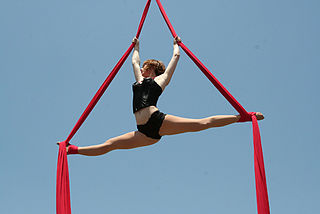A ligament is the fibrous connective tissue that connects bones to other bones. It is also known as articular ligament, articular larua, fibrous ligament, or true ligament. Other ligaments in the body include the:
No wave is a music genre, named for the transient avant-garde music and visual art scene from which it emerged in the late 1970s in downtown New York City.
Sa, SA, S.A. or s.a. may refer to:

Contortion is a performance art in which performers called contortionists showcase their skills of extreme physical flexibility. Contortion acts often accompany acrobatics, circus acts, street performers and other live performing arts. Contortion acts are typically performed in front of a live audience. An act will showcase one or more artists performing a choreographed set of moves or poses, often to music, which require extreme flexibility. The physical flexibility required to perform such acts greatly exceeds that of the general population. It is the dramatic feats of seemingly inhuman flexibility that captivate audiences.

Acrobatics is the performance of human feats of balance, agility, and motor coordination. Acrobatic skills are used in performing arts, sporting events, and martial arts. Extensive use of acrobatic skills are most often performed in acro dance, circus, and gymnastics, and to a lesser extent in other athletic activities including ballet, slacklining and diving. Although acrobatics is most commonly associated with human body performance, the term is used to describe other types of performance, such as aerobatics.
Buy may refer to a trade, i.e., an exchange of goods and services via bartering or a monetary purchase.

Chinese variety art refers to a wide range of acrobatic acts, balancing acts and other demonstrations of physical skill traditionally performed by a troupe in China. Many of these acts have a long history in China and are still performed today.

James Chance, also known as James White, is an American saxophonist, keyboard player, and singer.

A gurn or chuck is a distorted facial expression and a verb to describe the action. A typical gurn involves projecting the lower jaw as far forward and up as possible and covering the upper lip with the lower lip.
The contorsion tensor in differential geometry is the difference between a connection with and without torsion in it. It commonly appears in the study of spin connections. Thus, for example, a vielbein together with a spin connection, when subject to the condition of vanishing torsion, gives a description of Einstein gravity. For supersymmetry, the same constraint, of vanishing torsion, gives 11-dimensional supergravity. That is, the contorsion tensor, along with the connection, becomes one of the dynamical objects of the theory, demoting the metric to a secondary, derived role.
"Quintuplets 2000" is the fourth episode of the fourth season of the American animated television series South Park, and the 52nd episode of the series overall. In production order, this is the 3rd episode of Season 4. It was originally broadcast on April 26, 2000. The episode is based on the Dionne quintuplets and the then-recent Elián González affair, the case of a Cuban-born child who had been taken by federal authorities four days before the episode aired.
Contorts (arguably) is a portmanteau, or a combination of "contracts" and "torts" originated by Grant Gilmore in his book The Death of Contract. The generally informal term refers to the continual or persistent "tortification" of contract law. In other words, in recent years, principles from tort law increasingly have been applied to contract disputes and incorporated into the general body of contract law.

A split is a physical position in which the legs are in line with each other and extended in opposite directions. Splits are commonly performed in various athletic activities, including dance, figure skating, gymnastics, contortionism, synchronized swimming, cheerleading, martial arts, aerial arts and yoga as exercise, where a front split is named Hanumanasana and a side split is named Samakonasana. A person who has assumed a split position is said to be "in a split", "doing a split", or "doing the splits".

The botanical term “spur” is given to outgrowths of tissue on different plant organs. The most common usage of the term in botany refers to nectar spurs in flowers.

Robert "Mr. Fantastic" Muraine is a dancer in the popping style.

Aestivation or estivation is the positional arrangement of the parts of a flower within a flower bud before it has opened. Aestivation is also sometimes referred to as praefoliation or prefoliation, but these terms may also mean vernation: the arrangement of leaves within a vegetative bud.
Contortion Spur is the largest and easternmost of three spurs which descend northwards from Mount Madison near the mouth of Byrd Glacier in Antarctica. The spur exposes a spectacular syncline of white marble and black schist. It was geologically mapped on December 10, 2000, by Edmund Stump of the United States Antarctic Program; he suggested the name because of the skewed form of the spur.
3/3 is an infantry battalion in the United States Marine Corps.
Niebla caespitosa is a fruticose lichen that grows along the fog regions of the Pacific Coast of North America from southern California, including the Channel Islands, to the Vizcaíno Peninsula of Baja California. The epithet, caespitosa, is in regard to the clustered thallus branches spreading widely from a central attachment or holdfast

Contorted aromatics or more precisely contorted polycyclic aromatic hydrocarbons are polycyclic aromatic hydrocarbons (PAHs) in which the fused aromatic molecules deviate from the usual planarity.









